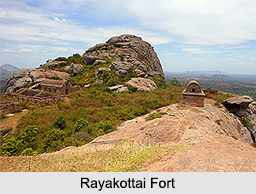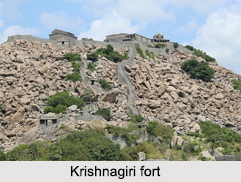 Some of the forts of Tipu Sultan have been renovated and some are lying intact, depicting the evidence of the reign of Tipu Sultan. All the engravings that are etched in the forts are the artistic representation of the adept artisans and the artistic bent of mind of the ruler as well. Among the forts of Tipu Sultan, the Hosur and Rayakottai forts were of maximum strategic importance.
Some of the forts of Tipu Sultan have been renovated and some are lying intact, depicting the evidence of the reign of Tipu Sultan. All the engravings that are etched in the forts are the artistic representation of the adept artisans and the artistic bent of mind of the ruler as well. Among the forts of Tipu Sultan, the Hosur and Rayakottai forts were of maximum strategic importance.
Interior Arts in forts of Tipu Sultan
The artistic creations inside the forts are the representation of the adept artisanship of the then artisans. The monuments are also replicas of the art and culture of the time of Tipu Sultan. The depth and the depiction of objects, especially in terms of detail and the rendering of solidity are remarkable. The aquatints of the forts depict an earthen fort of Tipu Sultan at Hosur, the Rayakottai fort, the Jagadevipalaiyam fort, the Virbhadradur and the Sankaridurg. The paintings bear the art and cultural affluence of the period and reflect both hard work and vigor of the artists. The light and shade effect and the distinctive and characteristic tints employed, bear affinity with the neoclassic tradition of landscape painting. In the aquatints" attempt at capturing a full view of a fort in its natural surroundings, only a little space is left in the composition for the central object. The historical worth of their oriental paintings is immense, since with the passage of time vital changes have occurred in the landscape. Some of the buildings have totally perished, or have been partly destroyed, altered or renovated. Their depiction of monuments is full of dramatic and emotional content.
Hosur Fort
The Hosur Fort was built on the route always taken by the Mysore armies to invade the Carnatic. On this specific route from Bangalore to the Carnatic, there were numerous forts and Lord Cornwallis considered the conquest of these places very important during the Third Mysore War. History says that to conquer Tipu Sultan"s earthen fort at Hosur, which was situated about 28 miles south-east of Bangalore, Cornwallis sent Major Gowdie who got it evacuated by Tipu"s troops on 15 July 1791. The garrison tried to blow up the fort but failed in their attempt due to Gowdie"s sudden advance.
 Rayakottai Fort
Rayakottai Fort
The Rayakottai fort was another important outpost used by Tipu Sultan"s forces on their military campaigns. The fort is situated within the town of Rayakottai. It is one of the ancient fortresses in the Krishnagiri district. It is now a protected monument by the Archaeological Survey of India. The fort was built on a granite rock and consisted of two forts connected by a rampart: one at the foot of the rock and the other on top of the rock. During the 18th century, Hyder Ali and Tipu sultan ruled this fort. In 1791, the fort was captured by Major Gowdie. It was during the third Anglo-Mysore War, by the Treaty of Srirangapatna, this fort later came into the hands of the British.
Krishnagiri Fort
Krishnagiri Fort is one of the strongest forts in the Krishnagiri district. It is protected by the Archaeological Survey of India. The fort was built by King Krishnadevarayalu of the Vijayanagar Empire. In the 18th century Hyder Ali captured this fort on the instruction of Chikka Devaraja Wodeyar, the then king of Mysore. In 1768 this fort got surrendered to the British after the blockade in the First Anglo-Mysore war. The fort remained in Tipu Sultan"s possession until the Treaty of Srirangapatna in 1792 which transferred it to the British.
Virbhadra Durg
In the depiction of Virbhadra Durg, the appearance of the ascending rugged passage, paved with stone blocks are observed. Approaching the fort is the immediate focus of the painters" view. The fort above is depicted with greatly diminished perspective, and thus once again, the scenery becomes prominent. One might feel that perhaps the distance between the fort and the rugged passage is bit too exaggerated. Here too, the outer walls encircling the citadel have now disappeared. Nevertheless, the main fort is still intact.
 Sankagiri Durg
Sankagiri Durg
Sankiri Durg, also known as the Sankagiri fort was built in the 15th century by the Vijayanagar empire. It has 14 fort walls built around a hill. The fort was a British tax storage facility for the region of Kongu Nadu. It was an important military base for Tipu Sultan. This is because only one side of the hill is climbable. All the other sides are too steep to climb. This fort has one death well, granary, two oil godowns, one explosives godown, two masjiths, two Varadharaja Perumal temples and former British Army administrative buildings. In addition to that, the aquatint of Sankari Durg is shown on a flat-topped hill. It is now in a ruined condition, and the rampart encircling the hill top and its summit has totally disappeared.
Srirangapatna Fort
Srirangapatna Fort is a historical fort located in the historical capital city in the South Indian state of Karnataka. The fort came to prominence during the rule of Tipu Sultan. The fort had Lal Mahal and Tipu`s palace, both of which were demolished during the British capture of 1799. The Daria Daulat Bagh, Gumbaj containing tomb of Tipu Sultan, Juma Masjid, Obelisk monuments and the Fort walls, the spot where Tipu Sultan"s body was found, the Sri Ranganatha Svami Temple and Thomas Inman`s Dungeon are maintained as protected monuments under the ASI.
The forts of Tipu Sultan and their depictions by the artists show the evidence of the kingdom ruled by Tipu Sultan. All the evidences depict the political and governing strategies adopted by his kingdom during that time. The forts were also built in a manner that secured the region and Tipu Sultan"s kingdom militarily against invaders.



















